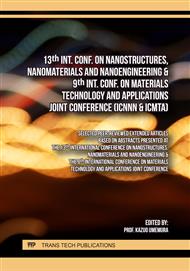p.3
p.17
p.39
p.45
p.51
p.59
p.67
p.75
Effect of Cold Isostatic Pressing on the Thermal Stability of PMMA Interlayer-Encapsulated MAPbI3 Perovskite Films
Abstract:
The thermal instability of the perovskite layer hinders the commercialization of perovskite solar cells (PSCs). In this work, the effect of cold isostatic pressing (CIP) on the thermal stability of poly (methyl methacrylate) (PMMA) interlayer-encapsulated methylammonium lead iodide (MAPbI3) perovskite (PMMA-MAPbI3) film was investigated. The MAPbI3 perovskite film was prepared via a vacuum-assisted solution process (VASP) on the SnO2-coated FTO glass substrate. Following this, a PMMA interlayer was spin-coated on the MAPbI3 film. The PMMA-MAPbI3 film was then vacuum-sealed in a thermoplastic bag and pressed in a CIP chamber filled with silicone oil at a pressure of 5 MPa for 10 min. The CIP-treated film was then subjected to thermal stressing at 150 °C for 1–5 h to compare its thermal stability against a pristine film untreated with CIP. The CIP treatment densified the MAPbI3 perovskite grains and enhanced the interfacial bonding between the PMMA interlayer and the perovskite film. These enhancements contributed to the superior thermal stability of the CIP-treated film, as its morphology retained most of the MAPbI3 perovskite grains with minimal conversion to PbI2 nanorods, evidenced by the minimal evolution of the PbI2 XRD peak. The photoluminescence (PL) spectra of the CIP-treated film showed higher retention of the emission peak at 770 nm after 5 h of thermal stressing, signifying less thermal degradation than the untreated pristine film. Thus, CIP is demonstrated as a simple method that can enhance the thermal stability of the PMMA-MAPbI3 film.
Info:
Periodical:
Pages:
39-44
Citation:
Online since:
March 2025
Authors:
Price:
Сopyright:
© 2025 Trans Tech Publications Ltd. All Rights Reserved
Share:
Citation:



